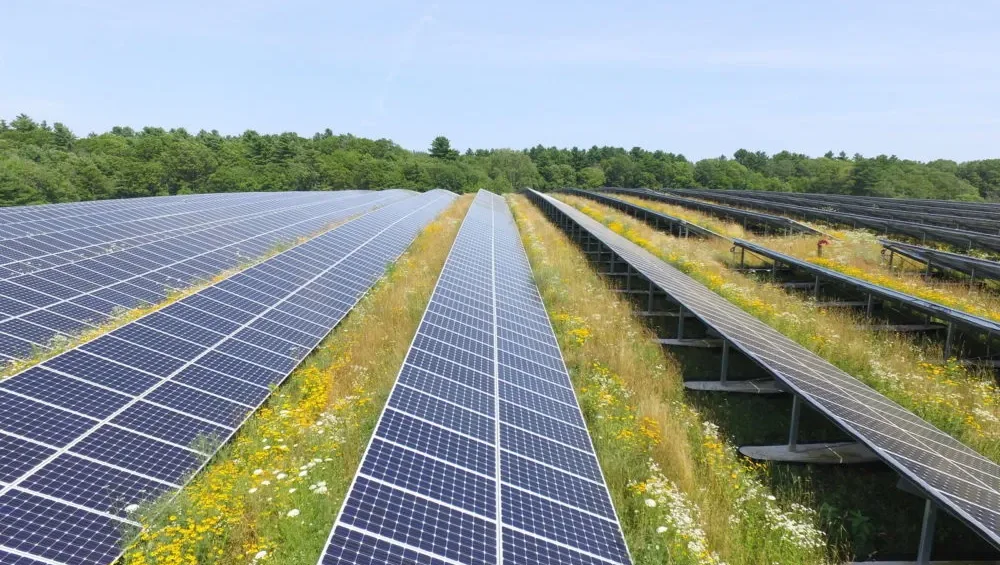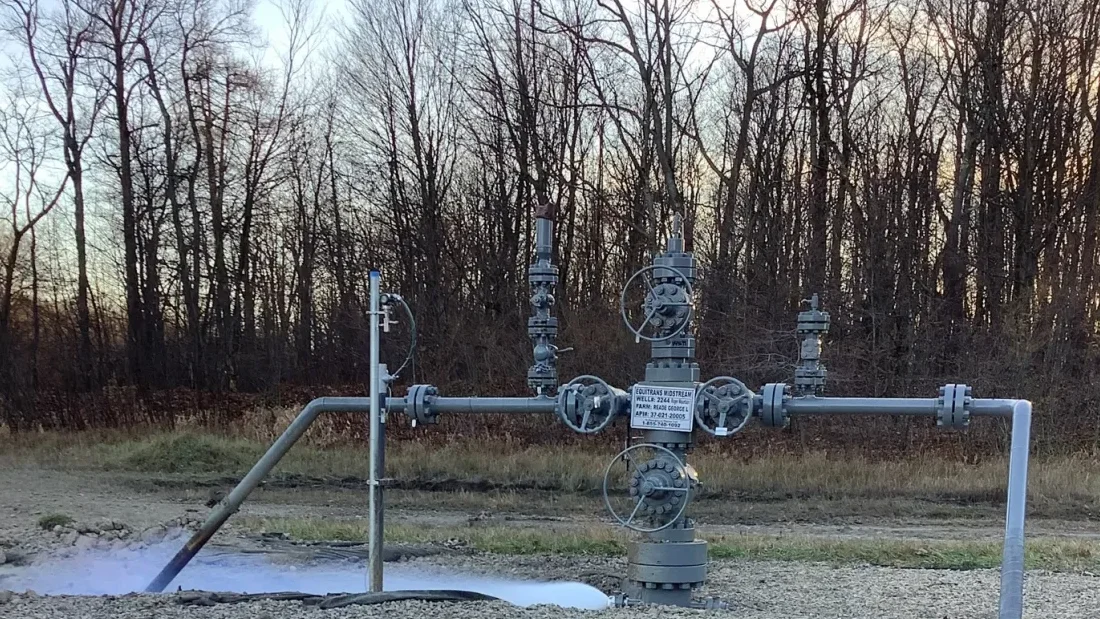
SOLAR: The first publicly available community solar project in New Hampshire hopes to pave the way for more such developments in a state where low net metering rates have made them challenging to complete. (Energy News Network)
ALSO:
NATURAL GAS: Massachusetts utility officials approve contracts between a liquefied natural gas terminal and three gas utilities that extend the facility’s life by at least six years. (Boston Globe)
COURTS: A Maryland circuit court judge dismisses complaints in a wider climate accountability lawsuit against the American Petroleum Institute but gives the city of Annapolis and Anne Arundel County 30 days to prove the trade group engaged in conspiracy. (E&E News, subscription)
GRID:
RENEWABLE ENERGY: Dozens of companies have responded to a call from the New York Power Authority to help the agency develop more renewable energy via public-private partnerships. (Times Union)
CLIMATE: Facing an unprecedented number of declared disasters since taking office, Maine’s governor plans to create a new commission to understand climate threats and mitigate potential impacts. (Portland Press Herald)
UTILITIES: New England utilities Avangrid and Central Maine Power may soon be taken private by the Spanish utility Iberdrola, which is already the utilities’ main stockholder, pending regulatory approvals. (Mainebiz)
BUILDINGS:
TRANSIT: Pittsburgh’s regional transit agency decides to permanently adopt a pilot program that automatically extended fare discounts to people receiving food assistance. (Pennsylvania Capital-Star)
ELECTRIC VEHICLES:

SOLAR: Analysts say most solar projects awaiting connection to the Western grid are hybrid installations paired with battery storage or wind facilities as California’s solar “duck curve” grows more pronounced. (Utility Dive)
ALSO:
CLEAN ENERGY: A New Mexico nonprofit launches a climate investment bank designed to finance clean energy projects benefiting low-income, disadvantaged and tribal communities. (Albuquerque Journal)
OIL & GAS:
COAL:
UTILITIES:
CRITICAL MATERIALS: Utah researchers find elevated recoverable concentrations of rare earth elements in active coal mines in Colorado and Utah. (news release)
GRID: California’s grid operator proposes raising the soft limit on power providers’ energy bids to better account for costs. (RTO Insider, subscription)
HYDROPOWER: Northwest tribal nations and federal agencies move forward on a plan aimed at restoring salmon runs decimated by hydropower dams on the Columbia River and its tributaries. (Idaho Capital Sun)

The first publicly available community solar project in New Hampshire hopes to pave the way for more such developments in a state where energy policies have made them challenging to complete.
The small southern New Hampshire town of Jaffrey is working with ReVision Energy to develop the array atop a former municipal landfill, with the goal of coming online in 2025. The town will receive annual lease payments for use of the land, and residents and others in the Eversource utility territory will be able to buy shares of the project, lowering their electricity bills and supporting the environmental benefits of renewable energy.
“It’s the perfect use of land that can’t do anything else,” said Jaffrey town manager Jon Frederick.
At the same time, planners hope the project helps demonstrate the potential for community solar in New Hampshire and spark policy changes that would make the concept more financially feasible in the future.
New Hampshire authorized the development of community solar in 2013, but only small-scale projects serving specific communities or neighborhoods have ever been built. The state’s energy policies have made larger, publicly available projects financially unworkable, even as other New England states have actively incentivized such projects by lowering logistical barriers and offering financial subsidies, said developers and clean energy advocates.
“The problem with community solar in New Hampshire is that the rate of reimbursement is much lower than the rate in all the surrounding states,” said Sam Evans-Brown, executive director of advocacy group Clean Energy New Hampshire.
At the heart of the problem are the state’s net metering rules. Net metering is a system that lets consumers offset the cost of power drawn from the grid by generating their own energy, often using solar panels. In New Hampshire, a solar system smaller than 100 kilowatts receives a credit worth 100% of the cost of transmission and the electricity itself and 25% of the cost of distribution. Systems between 100 kilowatts and 1 megawatt receive credit only for the power itself. Only municipal users can claim any credit for projects over 1 megawatt.
At the same time, community solar projects have higher administrative costs, as they need to track and reconcile the use of dozens or even hundreds of consumers. Traditionally, the net metering rates have not been high enough for community solar projects to make financial sense.
The lack of predictability is also a barrier: Electricity supply from Eversource in New Hampshire, for example, is currently priced at 8.29 cents per kilowatt-hour, down from 20 cents per kilowatt-hour over the same period last year. And the number changes every six months as the utilities update their rates.
“It is so volatile,” Evans-Brown said. “When you try to do the financial models, you’re kind of taking a bet.”
In Jaffrey, ReVision is taking advantage of evolving policies and using several strategies it hopes will overcome these obstacles.
In 2019, state legislation pushed by ReVision simplified the billing process for community solar customers. Previously, these consumers would receive a bill from the utility for their full month’s electricity use, as well as a payment from the solar operator for their share of the power generated. The new rules combined the processes, crediting the solar generation directly to a customer’s electricity bill. That streamlining was just enough to get things moving in Jaffrey, said Dan Weeks, ReVision’s vice president of business development.
“That was a big barrier in the past,” he said. “With that administrative progress we felt we were far enough to take this big step.”
The project deals with the size limit on net metered projects by keeping its AC capacity just below the 1 megawatt mark, so it remains eligible.
The company decided to sell shares in the development rather than opening it up to subscribers, a choice that creates more value for consumers, who get to own all the power produced and the associated tax credits. The idea is that consumers will receive low- or no-cost power even as retail electricity power prices increase, creating savings that will pay for the initial investment, and then some.
Historically, however, it was difficult to make those numbers pencil out because of the combination of low net metering rates and frequently changing power prices. Indeed, the current supply price of 8.29 cents per kilowatt-hour would not be enough to keep the project afloat. ReVision is banking on U.S. Energy Information Administration projections that power prices will go up in coming years, creating greater savings for shareholders.
“There will definitely be a different rate at the time it is turned on,” Weeks said. “We feel pretty confident that individuals will save regardless.”
An ongoing difficulty remains, however: State law requires the total consumption of the community solar group members be equal to or greater than production of the solar farm. However, many shareholders are interested in buying a stake that is larger than their consumption so the solar credits will offset their entire energy bill — the delivery of the power as well as the electricity itself. That leaves ReVision with an unbalanced equation.
This dilemma is likely an unintended side effect of the way net metering rules have evolved in the state, Weeks said. ReVision is in talks with legislators about how they might be able to change the law to remove this obstacle, a move that would benefit both the Jaffrey project and future community solar plans.
“We have willing legislators who want to address it, so the program can realize its intended goal,” Weeks said.
If a change in law does not come through, ReVision will look into partnering with nonprofit groups or municipalities that might be interested in buying smaller amounts of power to offset some, but not all, of their consumption, which would help rebalance the legally required equation.
As the plan comes together, others in the New England solar space will be watching, Evans-Brown said.
“The thing that’s exciting about ReVision doing this is it’s kind of a trial to see if we can make this work,” he said.

SOLAR: Wyoming regulators greenlight a proposed 771 MW solar-plus-storage facility on private land near Cheyenne. (Casper Star-Tribune)
ALSO:
OVERSIGHT: Arizona residents push back after a county approves a proposed natural gas peaker plant next to a retirement community shortly after banning new utility-scale solar installations. (Guardian)
CLEAN ENERGY: The U.S. Energy Department awards over $2 million to community groups and nonprofits to fund clean energy projects, including ones in six Western states. (news release)
TRANSPORTATION: Colorado lawmakers pass legislation aimed at expediting proposed passenger rail service between Denver and coal transition communities in the western part of the state. (Colorado Newsline)
GRID: Colorado Gov. Jared Polis signs legislation requiring utilities to update their distribution grids to support state electrification and decarbonization goals. (news release)
OIL & GAS:
CLIMATE:
COAL: Right-wing Wyoming lawmakers call on Gov. Mark Gordon to sue the Biden administration over its proposal to halt new federal coal leases in the Powder River Basin. (Cowboy State Daily)
LITHIUM:

CLEAN ENERGY: The location of a New Hampshire coal plant primes it well for a future of supporting offshore wind and energy storage projects, according to the facility’s owner. (Granite Geek)
EQUITY: Massachusetts’ residents with limited English proficiency face linguistic barriers to participating in or benefiting from the state’s energy assistance, assessment and weatherization programs. (WBUR/El Planeta)
CLIMATE: Even if Vermont’s governor, who hasn’t promised his signature, vetoes legislation making fossil fuel companies pay for climate damages, the legislature appears to have enough support to override him. (Heatmap)
WIND:
GRID:
SOLAR:
TRANSIT: The transit agency of Pennsylvania’s Cambria County purchases four new compressed natural gas buses to replace four diesel models. (Tribune-Democrat)

PIPELINES: New York environmental activists say they will continue working to end gas pipeline expansions in the state, saying “the fight has shifted” after the defeat of the Williams Pipeline project. (City Limits)
WIND:
SOLAR:
HYDROGEN: The energy firms looking to build a $1.5 billion hydrogen fuel facility at Pittsburgh’s airport say they can’t do so unless federal clean energy tax credits include coal mine methane projects. (Associated Press)
ELECTRIC VEHICLES:
BATTERIES: New York’s Staten Island currently has 13 lithium-ion battery energy storage sites under development, according to a state database of projects receiving incentives. (SI Live)
GRID:
WORKFORCE: Massachusetts and a social impact investment firm want to create a climate tech workforce training loan program to educate the 30,000 workers needed to achieve the state’s climate goals, planning to raise $10 million in funds to do so. (WHDH)
FOSSIL FUELS: Con Edison says a roughly 4,400-gallon oil spill into the Hudson River last month was due to a failed piping component and cracks in the floor of the power station. (W42St)

Ohio has seen a big jump in the number of agency orders forcing property owners to allow oil and gas development on their land, whether they want it or not.
The number of so-called “unitization” orders issued by the Ohio Department of Natural Resources has surged in recent years, peaking at 112 in 2022 and continuing at nearly 100 last year, according to data obtained from the agency by the Energy News Network.
The practice is common, with rules varying by state. In Ohio, lawmakers began working to streamline the process for oil and gas companies in 2019, coinciding with a decline in the state’s gas production after a seven-year fracking boom.
Those changes run contrary to other efforts in Ohio to restrict energy development in the name of neighbors’ private property rights, including strict wind farm setbacks passed in 2014 and a 2021 law allowing counties to block new wind and solar projects.
Under Ohio law, companies must meet several conditions before initiating unitization, including a showing that at least 65% of property owners in a project area consent to drilling.
Critics say the process was already tilted in the companies’ favor, and that the recent changes will make it even harder to block drilling or negotiate concessions.
“All the cards are stacked against us,” said Patrick Hunkler. In 2018, ODNR issued an unitization order for property he and his wife, Jean Backs, own in Belmont County, which is one of the state’s top-producing counties for oil and gas. The developer later canceled the project, so the order was revoked. More recently, Ascent Resources had tried to lease their land before backing out.

The legal process known as unitization has been available to Ohio oil and gas companies since 1965 but was rarely used until about a decade ago, after advances in drilling technology made it profitable to tap into harder-to-develop pockets of petroleum.
“The unitization process exists to protect the rights of those … who want to lease their minerals for development,” said Rob Brundrett, president of the Ohio Oil and Gas Association, “so that a small minority of owners … cannot stop everyone else from realizing the full potential of their property and minerals.”
For petroleum companies, the process has also promoted efficient oil and gas extraction. Otherwise, reduced pressure from too many wells could reduce the total recovery from an area.
Companies must show they have consent from owners of 65% of the area above a common oil and gas deposit before they can seek a unitization order. Companies also must show they tried to reach an agreement with holdouts, and that drilling under those properties is necessary to substantially increase the amount of oil and gas recovered. Any added value must also exceed the related costs.
“Our experience at the unitization hearing was that oil and gas runs the show,” Backs said.
Hearings don’t consider environmental impacts or other reasons landowners might not want drilling and fracking. “It’s just not part of the evaluation,” said Heidi Robertson, a Cleveland State University law professor who has written about unitization. Rather, she said, the basic question is: “Will adding this land to the unit make it easier for the developer to more efficiently and more profitably get the oil and gas out of the ground?”
The answer is almost always yes.
The Ohio Department of Natural Resources has denied only one unitization application since 2012, according to spokesperson Andy Chow. Meanwhile, it has approved more than 500 applications, with more than half the orders issued after 2020. The agency hired an additional employee in 2021 to deal with an increase in applications, Chow said.
Owners whose property is unitized won’t have pads or roads on their property, but they still get royalties and other payments. Ohio law requires “just and reasonable” compensation for landowners.
In most cases that compensation starts with a 12.5% royalty. Additional payments are adjusted for the developer’s expenses and other factors and the compensation is often smaller than that for voluntary participants. Orders typically have let companies recoup twice those amounts before unitized landowners can get payouts beyond royalties, said attorney Matthew Onest, whose firm has represented multiple landowners in oil and gas matters.
In some cases, property owners must wait even longer. At a March 27 hearing, for example, drilling company EAP Ohio asked for a “500% penalty” for owners who did not agree to a lease. Anna Biblowitz, a negotiator for Encino Energy, claimed the higher penalty was justified by the developer’s risk and “as a motivator for other working interest owners to participate.” A ruling in the case is due this month.
Some property owners, including Backs and Hunkler, worry about climate change and other environmental impacts. They said companies wouldn’t agree to requested lease terms for no flaring, methane monitoring and monitoring of the spring on their property.
“These oil and gas companies aren’t addressing the important issues of our environment,” Hunkler said.
Other landowners may hold out because they want more money, said Onest. “They kind of dig their heels in,” he said.
Industry experts said market forces could partially explain the rise in unitization cases. Property owners could hold out more often because they want higher payments like others got early on in the state’s fracking boom. Or, higher oil prices might be motivating companies to pursue projects that once seemed too complicated to be worthwhile.
State officials have made the process easier, too. In 2019, lawmakers added language about how to calculate the 65% threshold, tucking the terms into a 2,600-page state budget law. Matt Hammond, who was then president of the Ohio Oil & Gas Association, told lawmakers the added language was meant to “clarify” the law.
In practice, the change likely lowered a barrier for companies to use the tool, according to Clif Little, an Ohio State University Extension educator in Old Washington, Ohio. “If you’re seeing actually more [cases] for forced unitization, that would be a significant player in that,” Little said.
Another law passed in 2022 requires the Ohio Department of Natural Resources to hold hearings on unitization applications within 60 days. The agency must rule within 60 days of the hearing, and also let companies know in advance if an application is incomplete.
For industry, the primary benefit from the 2022 law change was to get certainty about timing. “This impacted how a producer was able to plan their drilling schedules,” said Mike Chadsey, director of external affairs for the Ohio Oil and Gas Association.
The Ohio Department of Natural Resources also changed its guidelines last year to standardize unitization applications. The agency’s website said the changes were “aimed at streamlining the review process” and that applications would include fewer documents.
Among other things, companies don’t need to file testimony from engineers, geologists and landmen in advance of hearings — something they had generally done in the past, said Robertson at Cleveland State. In her view, that further limits any dissenting landowners’ ability to prepare challenges to such testimony when the hearing does take place.
The Covid-19 pandemic also affected unitization hearings, which are now generally held via Zoom. “Allowing these meetings to be held via Zoom is a benefit to all parties involved,” Chadsey said, adding that it’s more convenient for landowners.
Folks in “suits and ties” had to come from out of state when ODNR held the unitization hearing for Hunkler and Backs’ property back in 2017. With a remote format, though, the hearing panel and company personnel “don’t have to look at you in person,” Hunkler said.
Oil and gas companies said they take every step to avoid forced leases, but that unitization is an important tool when that is not possible.
“When those means are exhausted, which often includes situations of poor record-keeping or the inability to locate an owner, unitization can be a tool to ensure property and mineral rights are realized by all stakeholders,” said Zack Arnold, president and CEO of Infinity Natural Resources.
Jackie Stewart, vice president of external affairs for Encino Energy voiced a similar position. “Encino makes every attempt to lease all landowners in each unit and only utilized unitization after all leasing efforts are exhausted, so the property rights of Ohio’s landowners can be realized,” she said.
“This isn’t something any lawyer can handle. You have to be an expert in this stuff,” Robertson said. “And all the experts are on the other side, because that’s where the money is.”
Robertson is unaware of any legislation to make matters fairer for landowners who don’t want to lease their land. And gerrymandering makes it unlikely such bills will be passed anytime soon. As she sees it, the process is “stacked against the dissenting landowner.”

A climate trust fund proposed in Portland, Maine, would use money from the sale of city-owned renewable energy credits to kickstart further efforts to cut local carbon emissions.
Portland is among the hundreds of U.S. cities that have adopted ambitious climate goals in recent years. Now, in search of sustained funding to meet those targets, many are turning to novel fiscal approaches, such as the one approved in Portland last week by the first of two city council committees.
The ordinance, if passed by the full council, would establish a new climate fund next year using money primarily from the sale of renewable energy credits, or RECs, from city-backed solar projects, such as at the Portland International Jetport and on the former city landfill.
The money could help pay for consulting work on emissions-cutting or resiliency projects, climate grant-related costs or local matches, community micro-grant programs for climate-friendly improvements, or other expenses for the city sustainability office.
“This is a new source of funding that can get invested in other city projects to, again, save more money,” said Bill Weber of Portland Climate Action Team, a local Sierra Club offshoot that’s been pushing for the city to make progress on its climate plan. The city, along with neighboring South Portland, adopted a shared target in 2020 of cutting emissions 80% over 2017 levels by 2050.
Proceeds from the sale of RECs would amount to about $300,000 to $400,000 a year, according to a memo from Portland sustainability director Troy Moon. It’s not enough to entirely fund major construction projects, Moon said, but “could provide leverage to launch such projects.”
The fund would also include money from “penalties paid for violations of sustainability related ordinances, private donations, proceeds from grants, and voluntary appropriations made by the Council,” he wrote.
Weber describes the proposed fund as “seed money for larger savings.” He suggested a study of solar potential across city schools’ rooftops as one hypothetical use, with results that could be used to attract developers, choose priority projects and speed along their implementation.
“A lot of these projects will pay for themselves over time, but you need to do some engineering,” he said.
Peyton Siler Jones, the Portland-based interim director of sustainability with the National League of Cities, said creative approaches are essential to creating long-term funding streams for local climate work.
“Figuring out how to have those savings not just go to the general fund, but go to a special climate fund to continue to implement climate projects, is one example of an innovative solution,” she said. “It’s exciting to see that being something that can be scaled and replicated in smaller communities.”
Siler Jones said Portland’s fund could be used to pay a consultant to write grants that could bring in federal funding. Or, she suggested as a hypothetical example, it could pay sustainability-related cost differentials on an affordable housing project — helping the developer by covering the extra cost of building materials to install heat pumps or funding a subcontractor to oversee climate-friendly engineering.
While she wasn’t sure whether this idea is happening anywhere as of now, she said the general principle of dedicating city funding to climate efforts is becoming more popular. Boston now puts at least 10% of all new capital funding toward “open space, infrastructure, and facilities projects that are climate resilient or contribute to making the City more environmentally friendly,” according to the city’s website.
Washington, D.C., has a long-running sustainable energy trust fund seeded with fees on electric, gas and fuel oil companies, as well as the sale of credits from the Regional Greenhouse Gas Initiative. And in Ann Arbor, Michigan, millions in annual proceeds from a 20-year property tax increase adopted in 2022 go toward community climate projects.
The idea of using REC sales to seed the fund, as proposed in Portland, involves a complicated trade-off.
The credits are an annual return for Portland’s investment in a given renewable energy project, essentially letting the city own proof of the progress on local emissions goals made by that investment. Selling those credits means selling that proof, and therefore that small piece of progress, in a given year.
“We have to be really clear that if we’re making the sale, we’re not using renewable energy per se,” Moon told city councilors before a committee vote on the proposed fund last week. “But… there’s an opportunity to use those RECs to fund climate action that may otherwise not be able to happen, and that also provides other benefits, like resilience and cleaner air and improved infrastructure.”
In comments to the council’s sustainability committee on the proposed fund, Weber argued that it’s imperative not to sell RECs to benefit anything other than continued, more substantial emissions cuts, meaning, he said, that the money should not be used for sustainability office salaries or resilience work.
“From my perspective a ‘trust’ represents a sacred commitment that is made to future generations,” Weber wrote. “Spending the revenue from the RECs on anything that doesn’t generate a material return on that investment breaks the trust.”
Before voting to advance the proposed fund last week, Portland city councilor Anna Bullett said she agreed that this funding should remain set aside for clear progress on city climate goals, not necessarily more general operations.
“We’re already paying for everyone’s salaries as is,” she said. “Let’s try to protect that money that we already budget for every year and not backfill it with this instead.”

WIND: The developers behind the 704 MW Revolution Wind project install the first foundation needed for the facility’s 65 turbines. (Providence Journal)
ALSO:
CLIMATE:
OIL & GAS: Pennsylvania lawmaker introduces legislation to bar local governments from receiving any state oil revenues if they sue oil companies, responding to a climate lawsuit filed by Bucks County against the fossil fuel industry. (E&E News, subscription)
TIDAL: The firm testing tidal energy turbines on Lake Erie says their prototype is better than that of their competitors because it doesn’t need to be plunged as deeply and is less visually intrusive. (Go Erie)
GRID:
SOLAR:
ELECTRIC VEHICLES: New York City records show that neighborhood stores and major online retailers alike are ignoring summons and cease and desist orders issued over uncertified e-bike battery sales. (The City)
BUILDINGS: In response to climate protests, a Baltimore art museum drafts a sustainability plan that its director says will hopefully include energy efficiency measures and rooftop solar. (Baltimore Sun)
COMMENTARY: A New Jersey doctor argues a free market approach to developing more clean energy doesn’t account for the “lives lost and illnesses caused by fossil fuel pollution.” (NJ Spotlight)

SOLAR: Solar developer Silicon Ranch’s planned 110 MW solar farm for customers of a Tennessee electric cooperative establishes a bulwark for community driven solar in the heart of the largely renewables-reluctant Tennessee Valley Authority’s service area. (Canary Media)
ALSO:
OIL & GAS:
CLEAN ENERGY:
ELECTRIC VEHICLES:
WIND: A newly completed 160 MW wind farm near Houston, Texas, was designed to withstand the region’s weather, including safety features for hurricanes. (KTRK)
NUCLEAR: A company will use a supercomputer at a Tennessee laboratory to train its artificial intelligence tool to guide nuclear power companies through applications for construction and operating licenses. (Knoxville News Sentinel)
CLIMATE: Florida Gov. Ron DeSantis signs legislation to erase the phrase “climate change” from state policy and instead promote “an adequate, reliable and cost-effective supply of energy for the state,” even as the state feels the brunt of rising seas and warming temperatures. (Miami Herald, Associated Press)
GRID:
EMISSIONS: Virginia will likely see more days rated with poor air quality, due more to the recent revision of federal pollution standards than to increased pollution. (WHRO)
COMMENTARY: The electric vehicle industry’s recent slowdown represents just a temporary delay in the clean vehicle transition as oil prices continue to fluctuate and EV technology rapidly advances, writes a quality manager at a Kentucky factory. (Courier Journal)